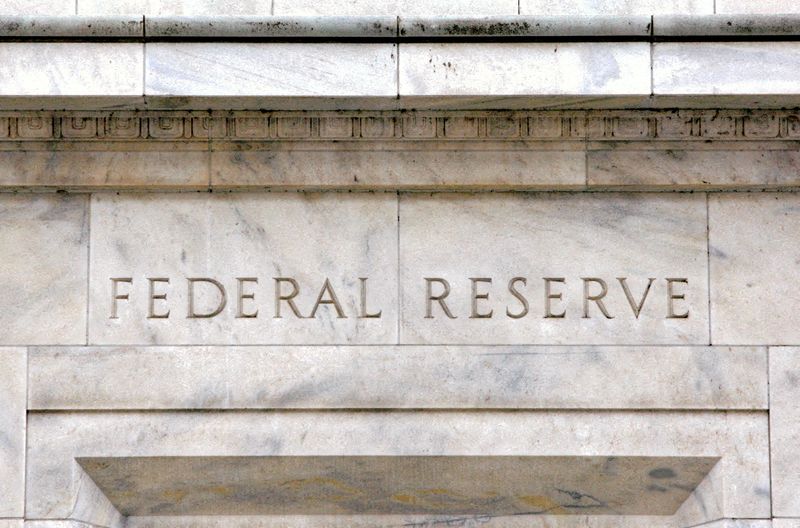
© Reuters. FILE PHOTO: The U.S. Federal Reserve building is pictured in Washington, March 18, 2008. REUTERS/Jason Reed/File Photo
FED
+0.51%
Add to/Remove from Watchlist
Add to Watchlist
Add Position
Position added successfully to:
Please name your holdings portfolio
Type:
BUY
SELL
Date:
Amount:
Price
Point Value:
Leverage:
1:1
1:10
1:25
1:50
1:100
1:200
1:400
1:500
1:1000
Commission:
Create New Watchlist
Create
Create a new holdings portfolio
Add
Create
+ Add another position
Close
By Michael S. Derby
NEW YORK (Reuters) – Federal Reserve losses breached the $100 billion mark, central bank data released on Thursday showed, and they’re likely to go a lot higher before the red ink stops.
The U.S. central bank is continuing to pay out more in interest costs than it takes in from the interest it earns on bonds it owns and from the services it provides to the financial sector. While there’s considerable uncertainty around how it will all play out, some observers believe Fed losses, which began a year ago, could eventually as much as double before abating.
William English, a former top central bank staffer now at Yale University, said he sees a “peak” loss of around $200 billion by 2025. Meanwhile, Derek Tang of forecasting firm LH Meyer said the loss is likely to be between $150 billion and $200 billion by next year.
The Fed captures its losses in what it calls a deferred asset, an accounting measure that tallies what it will eventually have to cover in the future before it can return to its normal practice of returning its profits to the Treasury. Losing money is very rare for the Fed. But at the same time, the central bank has cautioned many times that the situation in no way impairs its ability to conduct monetary policy and to achieve its goals.
A money-losing Fed has not been a surprise given its aggressive campaign to raise interest rates, which has taken the benchmark overnight interest rate from the near-zero level in March 2022 to its current 5.25%-5.50% range. With inflation pressures ebbing, it’s widely expected that the Fed is done with its rate increases, or close to it.
LIQUIDITY DESTRUCTION
But that doesn’t mean that the losses will stop mounting, as the current level of short-term rates will drive up the net negative income for quite some time. Instead, the losses will eventually stop primarily due to the Fed’s ongoing process of shrinking its balance sheet, which complements its rate hikes.
The Fed bought bonds aggressively during the coronavirus pandemic and its immediate aftermath, and in just over the last year it has shed about $1 trillion in Treasury and mortgage bonds. Fed officials have suggested there’s more to do on this front, and because of that, the central bank will have to spend less on interest because it is removing liquidity from the financial system. Financial markets are eyeing a stop in the second or third quarter of 2024.
The liquidity targeted by the Fed primarily exists in the form of bank reserves and in inflows to the central bank’s reverse repo facility. Through these tools, the Fed pays a mix of banks, money managers and others to park cash on its books, so if liquidity shrinks, it costs the central bank less to tie up what remains, even if its policy rate doesn’t change.
“The pace of losses will come down, even if interest rates stay high, because reserves and (reverse repos) are declining as securities run off, and new purchases of securities are earning the new, higher, rates,” English said. But he acknowledged “that’s all very rough” given how many factors and uncertainties are at play.
Bank reserves have fallen about $1 trillion from their peak at the end of 2021 and stood at $3.3 trillion as of Wednesday. Meanwhile, the reverse repo daily outstanding levels have fallen from more than $2 trillion a day between June 2022 and the end of June this year to $1.5 trillion on Thursday. Money market trading firm Curvature Securities said in a research note this week that it’s possible all the money will be out of reverse repos by the end of next year, returning the facility to where it stood just over two years ago.
POLITICAL PRICE
For some time the Fed has returned substantial amounts of money back to the Treasury, and this money has been used to lower government deficits.
James Bullard, the former head of the St. Louis Fed, said in an interview on Wednesday that he’s “worried” about the central bank’s losses and “it would be better not to do this.” He said it likely would have been better for the Fed to have kept some of the $1 trillion it has given the Treasury over the last decade to cover the sort of losses it is now navigating, but he noted that’s not the system Congress has set up.
Whenever the Fed does stop losing money, it will take years before it is able to take the deferred asset off its books and start returning cash to the Treasury. In 2022, the Fed handed back $76 billion, after returning $109 billion in 2021.
What’s more, those high levels of earnings were tied to the very low rates then in place. It remains an open question whether the Fed will be able to get back to that landscape, although some in the central bank, notably New York Fed President John Williams, are optimistic that can happen.
Source: Investing.com



























